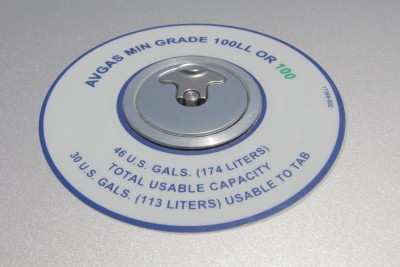Sat, Sep 24, 2011
Maximum Lead Content Is Reduced By 19% In New Fuel
 The FAA has issued a Special Airworthiness
Information Bulletin (SAIB) indicating that grade 100VLL aviation
gasoline meeting the American Society for Testing and Materials
(ASTM) fuel specification D910 is acceptable for use on aircraft
and engines certificated for operation with D910 grades 80, 91,
100, and 100LL aviation gasolines. Grade 100VLL meets all the
performance requirements of grades 80, 91, 100, and 100LL and
therefore meets the approved operating limitations for aircraft and
engines certificated to operate with these other grades of aviation
gasoline.
The FAA has issued a Special Airworthiness
Information Bulletin (SAIB) indicating that grade 100VLL aviation
gasoline meeting the American Society for Testing and Materials
(ASTM) fuel specification D910 is acceptable for use on aircraft
and engines certificated for operation with D910 grades 80, 91,
100, and 100LL aviation gasolines. Grade 100VLL meets all the
performance requirements of grades 80, 91, 100, and 100LL and
therefore meets the approved operating limitations for aircraft and
engines certificated to operate with these other grades of aviation
gasoline.
The FAA relies on ASTM International to develop fuel
specifications that applicants may designate as operating
limitations for their approved products. These aviation fuel
operating limitations may be listed in the product’s Type
Certificate Data Sheet (TCDS), Installation Manual, service
instructions, or as limitations associated with a Supplemental Type
Certificate (STC).
Grade 100VLL aviation gasoline (avgas) was developed by ASTM
International to provide a lower-lead alternative to 100LL in
response to impending environmental regulations. Grade 100VLL is
identical to 100LL in all aspects, except that the maximum lead
content is reduced by about 19%. The specification criteria for
lead content is expressed as only a maximum value, because avgas
producers routinely tradeoff lead content with other fuel
compositional changes to meet the specification criteria for Motor
Octane Number (MON). FAA survey data has shown that the lead
content can vary by up to 39% from the maximum lead value listed in
the specification while still meeting the MON minimum requirement.
Consequently, and most importantly, grade 100VLL has the same
minimum octane rating and will provide the same level of anti-knock
performance as 100LL and 100 avgas grades.

The FAA collaborated with industry on the ASTM International
task force that evaluated data supporting the incorporation of
grade 100VLL into specification D910. The FAA determined that grade
100 VLL meets all of the performance requirements of grades 80, 91,
100, and 100LL and will perform identically in existing aircraft
and engines.
Because grade 100VLL avgas that meets ASTM specification D910 is
identical to grade 100LL avgas, the following recommendations
apply:
- Grade 100VLL avgas is acceptable for use on those aircraft and
engines that are approved to operate with grades 80, 91, 100, or
100LL avgas.
- ASTM International standard D910 specifies blue coloration for
both grade 100VLL avgas and grade 100LL avgas, and, therefore,
these fuels are visually indistinguishable from each other.
- Operating limitations in Aircraft Flight Manuals, Pilot
Operating Instructions, or TCDSs that specify grades 80, 91, 100,
or 100LL avgas fuel are acceptable for use with grade 100VLL
avgas.
- Current aircraft placards that specify grades 80, 91, 100, or
100LL avgas are acceptable for use with grade 100VLL avgas.
- Operating, maintenance, or other service documents, for
aircraft and engines that are approved to operate with grades 80,
91, 100, or 100LL avgas, are acceptable for use when operating with
grade 100VLL avgas.
More News
According To The Witness, Once The Airplane Landed, It Continued To Roll In A Relatively Straight Line Until It Impacted A Tree In His Front Yard On November 4, 2025, about 12:45 e>[...]
"In the frame-by-frame photos from the surveillance video, the left engine can be seen rotating upward from the wing, and as it detaches from the wing, a fire ignites that engulfs >[...]
Radar Required A term displayed on charts and approach plates and included in FDC NOTAMs to alert pilots that segments of either an instrument approach procedure or a route are not>[...]
From 2023 (YouTube Edition): It’s a Small World After All… Founded in 2011 by pilot, aircraft designer and builder, and U.S. Air Force veteran Sam Watrous, Uncasville,>[...]
Also: UFC Buys Tecnams, Emirates B777-9 Buy, Allegiant Pickets, F-22 And MQ-20 The NTSB's preliminary report on the UPS Flight 2976 crash has focused on the left engine pylon's sep>[...]
 NTSB Prelim: Funk B85C
NTSB Prelim: Funk B85C Aero-News: Quote of the Day (11.21.25)
Aero-News: Quote of the Day (11.21.25) ANN's Daily Aero-Term (11.21.25): Radar Required
ANN's Daily Aero-Term (11.21.25): Radar Required Classic Aero-TV: ScaleBirds Seeks P-36 Replica Beta Builders
Classic Aero-TV: ScaleBirds Seeks P-36 Replica Beta Builders Airborne 11.21.25: NTSB on UPS Accident, Shutdown Protections, Enstrom Update
Airborne 11.21.25: NTSB on UPS Accident, Shutdown Protections, Enstrom Update




